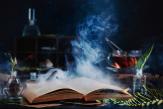News & reviews for the fiction lover in us all!
The Science of Magic: Quantifying the Extraordinary

Magic is, by far, one of the best elements of a great speculative fantasy, paranormal, or urban fantasy novel. Think about it. Our mundane lives are so utterly “normal” that the mere idea of something “magical” fills us with a sense of awe and wonder. We get a shiver down our spines every time our hero or heroine does something amazing and magical, and we can actually see it coming to life in front of us. This is wish fulfillment at its best—our desire for a world of magic and wonder, brought to reality through the pages of the books we read. But, like everything else in fiction, there are rules to magic. Just throwing it into a book and saying “Voila, magic!” with no explanation or quantification only works to a certain extent. We love reading about magic, but if there’s no way to wrap our heads around it, we start to lose the connection with it.
As readers, we’re creatures who want control and comprehension. Humans have delved deep into everything from biology to mathematics to quantum physics for the sole purpose of understanding the world around us. The more we understand, the easier it is for us to feel comfortable with our surroundings.
And the same goes for magic. A magic system that can be understood and quantified—even to a limited extent—is much more comfortable for readers to grasp than one with no boundaries or rules. A well-crafted magic system, which combines the magical with the structured, is utterly compelling.
Sanderson’s Laws of Magic
Brandon Sanderson, one of the best-known fantasy authors today, has codified a set of “laws” for crafting magic systems. This is by no means the standard, but it provides a fascinating insight into what makes a great magic system.
Law #1: The author's ability to resolve conflicts in a satisfying way with magic is directly proportional to how the reader understands said magic.
Basically, the more readers understand the magic, the more it can be used to solve problems.
Think about it: when a hero or heroine is flying on a dragon’s back, you know that gravity is going to drag them toward the ground. So when they do something death-defying like leaping to another dragon’s back, you feel tension and nervous excitement mixed with exhilaration when they actually achieve it. You understand gravity, so you understand the stakes the character faces when challenging it.
The same holds true for a great magic system. The more readers understand the rules and limitations, the more exhilarating it is when the character pushes the limits with their magic. Perhaps they come close to using too much magic and injuring themselves, or they find some creative new way to use magic that’s never been done before. The more readers understand the quantifications of the magic system, the more thrilling it is when pushed to its boundaries.
Read the entire article in the October 2019 issue of InD'Tale magazine.
You can just click on the magazine image on the left hand side of our home page to open and enjoy!
OR
If you would like to receive the magazine every month (for FREE!) , just sign up on our home page. Once you do, an e-mail validation notice will be sent directly to you. Just open and click the link and you're in - forever! Each month the magazine will be delivered directly to your inbox to downlad and read!



